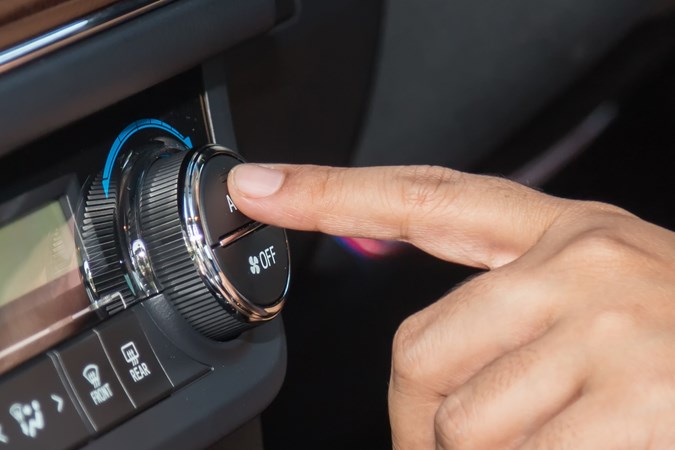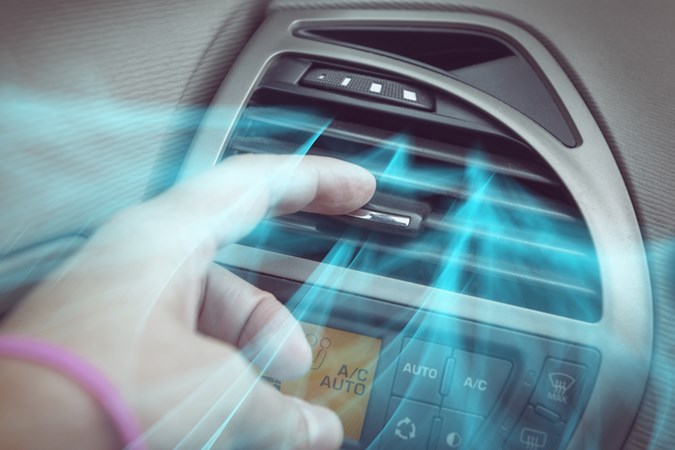One of the biggest annoyances of leaving a car parked outside during winter is having to demist the windows every morning. Fighting ice and condensation adds time you just don’t have to a drive already fraught with cold and (possibly) a lack of caffeine. And it’s important that you do fully clear your car’s windows before setting off – you could be fined £1,000 if the authorities think your car is too misted up to drive safely.
New cars tend to be well-equipped to clear their windows at the touch of a climate control button, but older cars often require some assistance with the process. Here are some top tips for managing the moisture in your car, getting you on the road as quickly and safely as possible.
Use the demist button
Among the buttons for your car’s climate control there’s one showing a curved rectangle and three squiggly arrows. That’s the button to demist the windscreen. Turn the engine on before pressing it.
In most cars, the demist function whacks up the fan speed and temperature to the maximum and directs pretty much all the airflow to the windscreen. It usually takes a minute or two to clear. But there is another way of slicing the demisting onion.
A number of car manufacturers including Volkswagen, Jaguar and Ford fit their cars with a heated windscreen. The button (which has the same demisting symbol) turns on heating elements embedded in the glass. It clears mist more quickly and can melt ice on the outside. Note that a heated windscreen is often linked to heated door mirrors.

Turn the blower on to demist the windscreen
Not every car has a demist button. If that includes yours, you can use the heating system’s blower to achieve the same effect. First, make sure the airflow is directed towards the windscreen. Then, turn the engine on and gradually increase the heater’s temperature and fan speed over a few minutes as the engine warms up.
If you put the fan on maximum speed before the engine is warm, you’ll just supercharge cold air into the car, which actually makes the misting worse. Don’t be tempted to leave your car unattended while the engine is running; opportunistic thieves have been known to nab them.

Run the demister while clearing the outside
It does take a few minutes for mist to clear from the inside of your car’s windows. Our advice is to turn the engine on and get the demisting process going first, then clear the outside of the windows of any condensation and ice. Also clear the door mirrors and the reversing camera lens, if your car has one. By the time you’ve finished, the inside of the windows should be clear.
Some cars, including many electric cars, have a pre-heating function. This allows you to remotely turn on the aircon to demist the windows and heat the interior before you get in, by using an app on your phone. The electric cars that offer this function need to be plugged into a charger at the time, so you don’t lose any range.
Point the side vents to demist the side windows
Your car’s windows can, of course, mist up while you’re driving. There’s a lot of moisture in your breath which condenses when it touches the windows, generating more mist. This can be a particular problem with the side windows, which you’re closest to.
To get around this, make sure the air vents at the ends of the dashboard are angled towards the windows. They’ll at least clear an area big enough for you to see the door mirrors, if not the entire window. The best way of making sure the side windows don’t mist up is to have the aircon set to a high enough temperature to dry your breath out. Somewhere around 20 degrees should do it.

Don’t wipe your car windows to demist them
There are all sorts of cloths and sponges that claim to be able to clear mist from your car’s windows. Some of them are reasonably effective, particularly microfibre cloths, but wiping a window can actually slow down the demisting process. That’s because the small droplets of condensation become big droplets as you wipe, and they take longer to evaporate.
It smears whatever dirt and grime is on the window, as well, potentially reducing visibility even more. In which case, the windows will need a polish as soon as possible.

Treat your car’s windows to avoid misting
Placing a sheet over the outside of a car’s windows is an old trick to stop them icing, but it doesn’t necessarily stop condensation developing inside. However, you could spray the inside of your car’s windows with rain repellent, which causes water to bead off glass rather than collect on it.
It’s intended for use on the outside but, in our experience, it’s also pretty effective at reducing condensation on the inside. If that doesn’t work well enough for you, you could invest in a car dehumidifier.
-
Do you use hot or cold air to demist?
Hot air from your car's blower is best for demisting the windows. That's because the cleanest, most efficient way to remove moisture from the glass is to evaporate it, and only hot air will do that.
-
Does opening windows help demist a car
It can help. A potential issue when demisting windows is that the air inside the car becomes laden with moisture as the mist evaporates off; if that air doesn't have anywhere to go, it can just condense on another window, misting it up. Having a window or two open will help pull that moisture-laden air out of the car. Similarly, having a window open while you drive will help prevent the windows misting up as, again, the moist air inside will be pulled out.
-
How do you defog a car quickly?
A lot of people try to quickly defog their car windows by wiping the moisture off with a cloth. Trouble is, unless the cloth is highly absorbent and very clean, you may you just smear moisture and dirt across the glass, which isn't especially helpful. The better solution is to direct your car's airflow and point the vents towards the glass and gradually turn up the heat and fan speed as the engine warms up. Or hit the demist button if your car has one.
Just so you know, we may receive a commission or other compensation from the links on this website - read why you should trust us.










